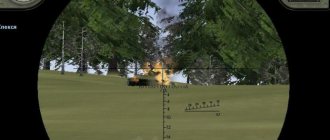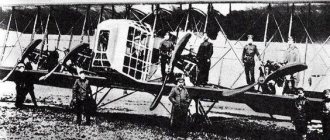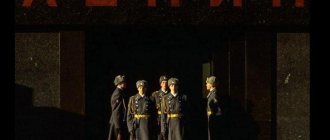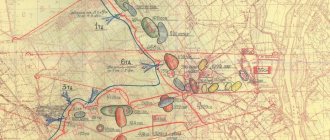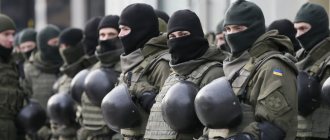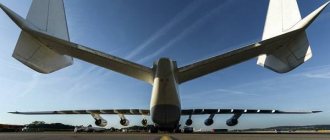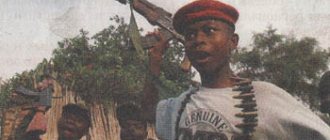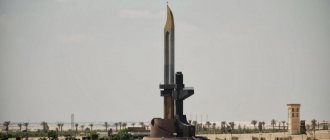Airborne Forces of the USSR and Russia[ | ]
Airborne Forces of the USSR
Main article: USSR Airborne Forces
At the end of 1930, a Soviet airborne unit was created near Voronezh - an airborne detachment. In December 1932, he was deployed to the 3rd Special Purpose Aviation Brigade, which in 1938 became known as the 201st Airborne Brigade.
The first use of airborne assault in the history of military affairs occurred in the spring of 1929. In the city of Garm, besieged by the Basmachi, a group of armed Red Army soldiers was dropped from the air and, with the support of local residents, defeated a gang that had invaded the territory of Tajikistan from abroad. However, Airborne Forces Day in Russia and a number of other countries is August 2, in honor of the parachute landing at a military exercise of the Moscow Military District near Voronezh on August 2, 1930.
In 1935, major military exercises took place in the Kiev Military District, during which, for the first time in the history of the USSR, a mass airborne landing was practiced with the aim of capturing the Brovary airport. The whole operation took no more than 2 hours. British Field Marshal Archibald Wavell also witnessed this airborne assault.
In 1939, they took part in the defeat of the Japanese at Khalkhin Gol.
In 1940, they took part in the operation to annex Bessarabia to the USSR.
USSR Airborne Forces sleeve insignia (from 1969 to 1991)
During the Great Patriotic War, the Airborne Forces were widely used in the counteroffensive near Moscow - in the winter of 1942, the Vyazma airborne operation was carried out.
In September 1943, an airborne assault was used to assist the troops of the Voronezh Front in crossing the Dnieper River.
Landing operations were used in the Manchurian Strategic Operation in August 1945.
In August 1944, the Airborne Forces were united into the Separate Guards Airborne Army, and on December 18, 1944, by order of the SVGK KA No. 0047, the army was disbanded. On its basis the 9th Guards Army was formed. All airborne divisions and brigades have been reorganized into guards rifle divisions and corps. The remaining three airborne brigades (5th, 8th, 24th) were transferred to the KA Air Force. Lieutenant General Ivan Ivanovich Zatevakhin was appointed head of the airborne forces department of the airborne forces of the spacecraft.
On June 10, 1946, by order of the Minister of the USSR Armed Forces, on the basis of the resolution of the Council of Ministers of the USSR of June 3, 1946, the Airborne Forces were transferred to the ground forces of the Armed Forces of the USSR, directly subordinate to the Minister of the Armed Forces of the USSR, being the reserve of the Supreme Commander-in-Chief, and General Colonel Glagolev Vasily Vasilievich.
In 1956, two airborne divisions took part in the Hungarian events.
In 1968, airborne divisions landed at two Czechoslovakian airfields during Operation Danube.
airborne troops were created for the first time in the world
, which had their own armored vehicles and self-propelled artillery. In the Afghan War (1979-1989), one airborne division, one separate air assault brigade, one separate parachute regiment and two air assault battalions as part of separate motorized rifle brigades participated from the airborne and air assault formations of the USSR Armed Forces .
Airborne Forces of the Russian Federation
Main article: Airborne Forces of the Russian Federation
The Russian Airborne Forces have the status of a separate branch of the Armed Forces of the Russian Federation. They are the reserve of the Supreme High Command.
- Airborne flag
- Middle airborne emblem
- Russian paratroopers at the Victory Parade
- Russian paratroopers during exercises in Kazakhstan
Compound
Has main components:
- air assault regular;
- paratrooper;
- air assault mountain.
The provision of components is carried out by connections and parts.
What divisions are included:
- 7th Guards air assault mountain (Novorossiysk);
- 76 Guards air assault (Pskov);
- 98 Guards airborne (Ivanovo);
- 106 Guards airborne (Tula).
The DSB includes:
- 11th separate guards DShBr (Ulan-Ude);
- 31 separate guards DShBr (Ulyanovsk);
- 56th separate guards DShBr (Kamyshin);
- 83rd separate guards DShBr (Ussuriysk);
- 45 separate guards special forces brigade (Kubinka);
- 345 guards parachute regiment (Voronezh);
- 38th Guards communications regiment (Moscow region);
- 150 ORVB (Moscow region);
- 35th separate medical detachment of the Airborne Forces (Pskov).
This is interesting! How to become a cadet: how boys and girls can enter a cadet school
Purpose of the Airborne Forces
Airborne assault has its purpose both in peacetime and in wartime. In normal circumstances, the armed forces carry out measures to maintain personnel and military equipment in constant mobilization and combat readiness.
The purpose of airborne units in wartime is to throw them across the front line into enemy rear to solve the following tasks:
- conducting raids;
- capture, disablement and destruction of controls;
- disruption or destruction of communication lines and other communications;
- capture, retention or destruction of important objects;
- taking over bridgeheads or areas of terrain and holding them;
- preventing second echelons from entering the battle;
- carrying out reconnaissance or sabotage activities.
Landing can be performed by parachute or landing method.
During combat operations as part of their own troops, the Airborne Forces can be used to encircle and destroy airborne assault forces or enemy troops that have broken through to cover or defend individual most likely directions of enemy action.
Your visit
How to get there
- From the Shchelkovsky bus station on buses going to Shuya, Palekh, Kineshma, Yuzha or directly to Ivanovo;
- From Yaroslavsky railway station by train going to Ivanovo;
- From Domodedovo on Rusline flights;
- You can get to the part by taxi: 7 (493-2) 39-09-39; 7 (493-2) 344-500; 7 (493-2) 41-01-41.
Where to stay
Apartments:
- 7 – Karina Eduardovna. Apartment with washing machine and internet, but on the 5th floor. House without elevator;
- 7 – Novel. Two-roomed flat;
- 7 – Andrey. Two-room apartment with all amenities.
Hotels:
- Hotel" Tourist". Located in the city center, rooms with all amenities. Phone for reservations: 7 (493-2) 37-65-19;
- Hotel "Onegin". Located in the center, in an old building. Phone for reservations: 7 (493-2) 580-111;
- Hotel "Soyuz". Located in the city center, the rooms have all the amenities, cashless payments are possible. Phone for reservations: 7 (493-2) 90-00-05.
Accommodation reservations should be made in advance.
vote
Article Rating
Into the maelstrom of the Airborne Forces
In 1950, Vasily Margelov unexpectedly took command of the Far Eastern Special Airborne Corps. For many, such a position would have seemed humiliating at that time. The airborne troops had a bad reputation. Until the age of 40, Vasily Margelov could not even think that his entire subsequent life would be connected with heaven. I didn’t even see the parachute at all. And he made his first jump on orders, already being a general. In the landing force, this age is considered pre-retirement. But Margelov had nowhere to retreat - the order was given. First jump from a balloon basket. Height 400 meters. There are rumors that before taking the position of commander of the Airborne Forces, Margelov made a bet with General Denisenko on 6 jumps. Denisenko died on the third jump. But Mareglov did not stop. He only broke his legs twice, but it was difficult to break his pressure. These six jumps became a kind of initiation into the Airborne Forces.
Helpful information
The 51st regiment does not have an official website. Address: military unit 33842, Tula, st. Komsomolskaya, 190. On the envelope it is necessary to indicate the unit (company number) and full name, patronymic and surname.
Important! You are allowed to visit a serviceman on weekends and holidays, as well as when he is not on duty. Soldiers take the oath in the city of Tula at the address: st.
Komsomolskaya, 190. Letters and parcels can be sent to the following addresses (depending on where the conscript is serving):
Soldiers take the oath in the city of Tula at the address: st. Komsomolskaya, 190. Letters and parcels can be sent to the following addresses (depending on where the conscript is serving):
- 300020, military unit 33842, Tula, st. Komsomolskaya, 190 (company number and full name of the serviceman must be indicated);
- 301113, military unit 33842, Tula region, Leninsky district, p/o Slobodka (required unit number, full name).
The 51st Airborne Regiment is located in military unit 33842
What to put in the parcel
In addition to products - nuts, dried fruits, sweets, cookies, waffle cake, etc. – you must put:
- disposable razors (two to three pieces);
- cream for shaving and subsequent skin care (to avoid irritation);
- brush;
- toothpaste;
- cheap toilet soap (better than Russian production);
- nail clipper (folding nippers so you can quickly cut your nails or remove a hangnail);
- white cotton fabric for hemming collars;
- threads of white, black, protective green shade;
- strong needles with a large, medium-sized eye;
- black polish and a brush for cleaning boots.
Material and living conditions of the military personnel of the unit
Almost all military personnel today serve in unit 32364 under a contract.
Payments to military personnel here are proportional to the positions they occupy, plus once a quarter they receive a bonus and free sanatorium-resort treatment. In addition, after signing a contract, a newly arrived soldier in the unit receives so-called “lifting allowances”.
As for housing, military families here are entitled to service apartments, received on a first-come, first-served basis. In the meantime, until their turn comes, they have the opportunity to rent housing in the nearest settlements - the village of Sosnovy Bor or Ulan-Ude. Moreover, all contract workers are compensated for rent on a monthly basis in a set amount, which depends on the number of members in the family.
On the territory of the unit itself, the military are located in dormitories with all the necessary living conditions: kitchens, showers, rest rooms, storage rooms. They have a medical center and a library at their disposal. And the village also has everything necessary for a comfortable life and recreation, in particular, a clinic, sports facilities, a House of Creativity, a post office, a hotel, laundries, shops, and ATMs.
ATM addresses:
- Asian-Pacific Bank: st. Balkhatinova, 9: from 9.00 to 19.00 except Sunday;
- Otp-bank: 50 Let Oktyabrya Avenue, 6: 24 hours a day;
- Rosselkhozbank: st. Mayakovsky, 1: 24 hours a day;
- Russian Standard: st. Stroiteley, 64: except Sunday.
Information for parents of conscripts
When preparing parcels, remember that it is prohibited to put any medications inside. They will still be taken away during inspection. However, with a doctor's certificate, an inhaler is permitted. If vitamins are needed, they are given to the medical office, and the soldier receives them from the doctor.
The soldier may keep the phone if he does not abuse it. No one will take away a means of communication if they use it only in their free time. It is recommended to write messages to the soldier, and whenever possible, servicemen themselves call their relatives.
If, nevertheless, the phone is taken away, then it is issued on a day off once a week. If unauthorized use of a mobile phone is suspected, the serviceman is called by the commander, and the communication device is confiscated until the end of the proceedings.
Conscripts may go on leave only with their parents, in agreement with their commander. Legal wives can obtain permission. You won't be able to go out with a girl.
Air assault formations, their differences from parachute units
Along with the parachute units, the air force also had air assault units, which were directly subordinate to the commanders of the military districts. Their differences consisted in the performance of various tasks, subordination and organizational structure. The uniform, weapons, and training of personnel were no different from parachute units.
This strategy was based on the use of massive landings behind enemy lines, with the aim of disorganizing the defense and causing panic in the enemy ranks. Since the army air fleet was equipped by this time with a sufficient number of transport helicopters, it became possible to conduct large-scale operations using large groups of paratroopers.
In the 1980s, 14 brigades, 2 regiments and 20 air assault battalions were stationed throughout the USSR. One DSB brigade was assigned to one military district. The main difference between the parachute and air assault units was the following:
- The parachute formations were 100 percent provided with specialized airborne equipment, while the air assault formations had only 25 percent of such armored vehicles. This can be explained by the various combat missions that these formations were supposed to carry out;
- Units of the parachute troops were subordinate only directly to the command of the Airborne Forces, in contrast to the air assault units, which were subordinate to the command of the military districts. This was done for greater mobility and efficiency in case of need for a sudden landing;
- The assigned tasks of these formations also differed significantly from each other. Airborne assault units were to be used for operations in the immediate rear of the enemy or in territory occupied by the enemy's front-line units, in order to cause panic and disrupt the enemy's plans with their actions, while the main parts of the army were to strike at him. The parachute units were intended to land deep behind enemy lines, and their landing had to be carried out non-stop. At the same time, the military training of both formations was practically no different, although the intended tasks of the parachute units were much more complex;
- The parachute units of the Airborne Forces have always been deployed at full strength and are 100 percent equipped with vehicles and armored vehicles. Many air assault brigades were understaffed and did not bear the title “Guards”. The only exceptions were three brigades, which were formed on the basis of parachute regiments and bore the name “Guards”.
Preparation
Gaza Strip - Demobilization
The command staff of the airborne battalion was most often selected from the airborne forces, and battalion commanders, deputy battalion commanders, and company commanders were selected from the nearest military districts. In the 70s, due to the fact that the leadership decided to repeat their experience - to create and staff the DSB, the planned enrollment in educational institutions expanded
, who trained future airborne officers. The mid-80s were marked by the fact that officers were released to serve in the Airborne Forces, having been trained under the educational program for the Airborne Forces. Also during these years, a complete reshuffle of officers was carried out; it was decided to replace almost all of them in the DShV. At the same time, excellent students went to serve mainly in the Airborne Forces.
To join the Airborne Forces
, as in the DSB, it is necessary to meet specific criteria:
- height 173 and above;
- average physical development;
- secondary education;
- without medical restrictions.
If everything matches, then the future fighter begins training.
Particular attention is paid, of course, to the physical training of airborne paratroopers, which is carried out constantly, starting with a daily rise at 6 am, hand-to-hand combat (a special training program) and ending with long forced marches of 30–50 km. Therefore, each fighter has enormous endurance and endurance, in addition, guys who have been involved in any sport that develops that same endurance are selected into their ranks
To test it, they take an endurance test - in 12 minutes a fighter must run 2.4-2.8 km, otherwise there is no point in serving in the Airborne Forces.
It is worth noting that it is not for nothing that they are called universal fighters. These people can operate in various areas in any weather conditions absolutely silently, can camouflage themselves, own all types of weapons, both their own and the enemy’s, control any type of transport and means of communication. In addition to excellent physical preparation, psychological preparation is also required, since fighters have to overcome not only long distances, but also “work with their heads” to get ahead of the enemy throughout the entire operation.
Intellectual aptitude is determined using tests compiled by experts. Psychological compatibility in the team is necessarily taken into account; the guys are included in a certain detachment for 2-3 days, after which the senior officers evaluate their behavior.
Psychophysical preparation is carried out
, which implies tasks with increased risk, where there is both physical and mental stress. Such tasks are aimed at overcoming fear. At the same time, if it turns out that the future paratrooper does not experience a feeling of fear at all, then he is not accepted for further training, since he is quite naturally taught to control this feeling, and is not completely eradicated. Airborne Forces training gives our country a huge advantage in terms of fighters over any enemy. Most VDVeshnikov already lead a familiar lifestyle even after retirement.
In defense of the southern borders
The 7th Airborne Division was formed in October 1948 on the basis of the 322nd Guards Parachute Regiment, which received its baptism of fire in the battles for Hungary and Czechoslovakia in the last months of the Great Patriotic War. The vast majority of the division's officers and warrant officers participated in the Afghan campaign; in 1993-1996, paratroopers carried out a peacekeeping mission in Abkhazia, and from 1995 to 2004 they fought with terrorists in Chechnya. For the successful completion of combat missions, courage, bravery and heroism, 18 servicemen of the division were awarded the title of Hero of Russia.
The materials of the Ministry of Defense note that currently the 7th Guards Air Assault Division is equipped with the most modern weapons, military equipment, landing and communications equipment.
Also on topic
“It is impossible to compete with Russia”: what results has Moscow achieved in strengthening the Arctic air defense system? The motorized rifle brigade of the Northern Fleet accepted a division of the latest Tor-M2DT anti-aircraft missile systems for experimental combat duty,...
Analysts called the joint exercises held this summer in Crimea with military transport aviation units an indicator of the high professionalism of the Novorossiysk Airborne Division. In the first half of July, more than 2.4 thousand soldiers of the formation landed on the peninsula. This was the first time such large-scale maneuvers had been carried out.
The disembarkation of military personnel was ensured by 40 Il-76 aircraft, which took off from the Ivanovo-Severny and Ulyanovsk-Vostochny airfields. The landing was carried out from low altitudes (from 600 to 900 m), and simultaneously from all vehicles. After landing, the fighters of the 7th division destroyed the objects of the mock enemy and illegal armed groups, and also captured the field airfield.
“The fact that the landing sites on which the landing was carried out are among the most difficult, since they are located near the sea, and also the fact that the landing from aircraft was carried out in two parallel streams of 20 aircraft each at minimal distances between them, required commanders and personnel should be more thoroughly trained in practicing landing issues in these conditions,” said Deputy Chief of Staff of the Airborne Forces, Major General Alexei Naumets.
- Russian military personnel carry out landing
- RIA News
According to the commander of military transport aviation, Lieutenant General Vladimir Benediktov, the use of this tactical technique “can significantly reduce the landing time.”
Also, paratroopers regularly perform tasks within the framework of maneuvers of the Collective Security Treaty Organization (CSTO).
Service today
Today, the 56th Airborne Battalion is engaged in training soldiers undergoing military service, and they also undergo it here under contract. In addition to the excellent physical training that a paratrooper must have, personnel are also trained in other skills. For this purpose, trips to the training ground are regularly organized, where combat exercises are held in field conditions close to military ones.
At this time, the soldiers live in tents, food is provided on their own, using a field kitchen. During trips, daily rations are provided. According to the military personnel, the food is quite high in calories, varied and tasty. On holidays, fighters are treated to chocolate, pastries and even barbecue.
Most of the soldiers who served in Kamyshin are proud that they belong to the Airborne Forces. The 56th DSB trains paratroopers, so the mandatory program includes parachute jumping. This involves jumping from a helicopter and an airplane. Contract workers who complete the jumping program receive an additional payment to their salary.
